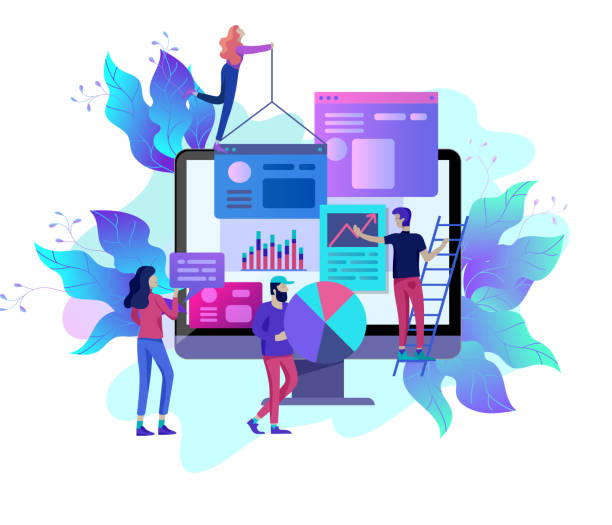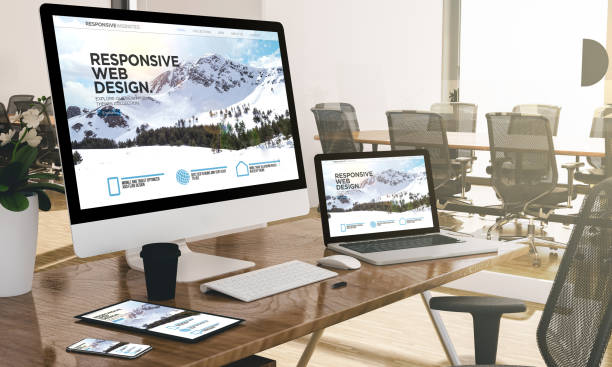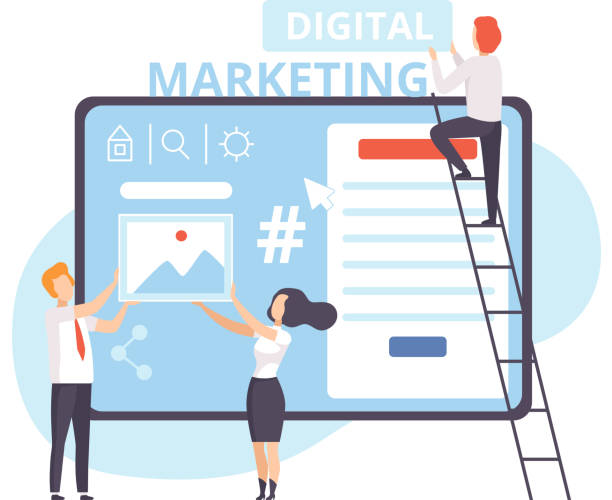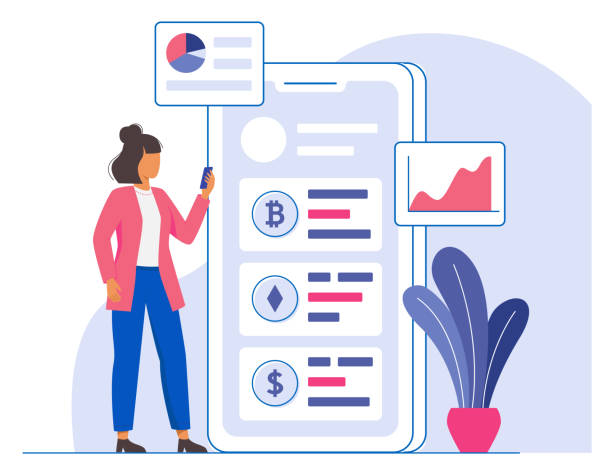The Importance of Speed in Today’s Digital World

In the current digital age, speed is paramount.
Imagine entering a store and having to wait hours to find the product you’re looking for.
Most likely, you’d leave immediately, right? The web world is exactly the same.
Fast website design is no longer a luxury option, but a vital necessity for survival and success in today’s competitive market.
Internet users have little patience, and statistics show that if a website takes more than 3 seconds to load, it loses more than half of its visitors.
This is not just a number, but it represents lost opportunities, potential customers who will never know you, and ultimately, revenue that will never be earned.
These figures clearly demonstrate how slight delays can directly impact a business’s capital and profitability.
Website speed not only affects user interaction but also implies brand credibility and professionalism; a fast and smooth-running site instills a sense of trust and quality in the audience.
This raises the question: Can your business afford this loss? Are you ready to concede the field to your competitors because of your slow website? The importance of fast website design goes beyond just a good user experience; it directly impacts your SEO and your site’s ranking in search results.
Search engines like Google prefer websites that offer a better user experience, and loading speed is one of the main factors in this experience.
The faster your site, the higher your chances of being seen by your target audience, which means more traffic, more leads, and ultimately, more sales.
In this comprehensive article, we will delve into the various aspects of fast website design and the strategies to achieve it.
This is an investment with guaranteed returns in the digital world and is essential for any online business seeking competitiveness and sustainable success.
Are you tired of your company’s website not meeting your expectations? With Rasawwb, design a professional website that truly represents your business.
✅ Increase new customer acquisition and sales leads
✅ Enhance your brand’s credibility and trust with your audience
⚡ Get a free website design consultation!
Key Factors Affecting Website Speed

To achieve fast website design, we must first identify the factors that influence it.
Website speed is a function of several technical and content-related factors, each of which can affect the site’s overall performance.
One of the most important factors is server response time.
If your website’s hosting server is slow or overloaded, you won’t be able to achieve the desired speed, even with the most optimized coding.
Choosing a reputable and high-quality hosting provider, such as cloud computing services or dedicated hosting, is the first step in this direction; there’s a significant difference in response time between shared hosts and dedicated servers.
Another factor is optimizing images and media.
High-volume images without proper compression can significantly reduce site loading speed.
Using modern image formats like WebP and lossless compression are essential strategies in this regard.
Also, optimized coding and file compression play a vital role.
Removing unnecessary code, compressing CSS and JavaScript files, and using clean, structured HTML significantly help reduce the overall size of the site.
Failure to optimize web fonts can also lead to delays in page rendering, so using standard fonts and optimizing custom fonts is also important.
Caching is another powerful technique for increasing speed.
By temporarily storing a copy of pages and files in the user’s browser or on the server, subsequent visits do not require reloading information from scratch, and the site is displayed much faster.
Finally, using a Content Delivery Network (CDN) can also significantly help with fast website design.
A CDN stores copies of your site’s content on multiple servers in different geographical locations, ensuring that content is delivered from the server closest to the user, minimizing latency.
All these factors together complete the puzzle of website speed, and neglecting any one of them can harm your user experience and SEO ranking.
Investing in these areas is a smart investment for the future of your online business.
Advanced Speed Optimization Techniques

After identifying the key factors, it’s time to implement advanced techniques to achieve fast website design.
These techniques require technical knowledge and precise implementation but yield significant results in improving website performance.
Gzip compression is one such method that significantly reduces loading time by decreasing the size of text files (HTML, CSS, JavaScript) before sending them to the user’s browser.
This process occurs on the server side, and the user’s browser receives and decompresses the compressed files.
Newer protocols like Brotli offer even better compression performance and can further help reduce data volume.
Minification, or code shrinking, is the process of removing unnecessary characters such as spaces, comments, and new lines from code files.
This reduces the file size without altering functionality, allowing the browser to process them faster.
This process is highly beneficial for CSS, JavaScript, and even HTML files.
For fast website design, using Lazy Loading for images and videos is also crucial.
This technique ensures that media content is loaded only when the user scrolls near it on the page, not from the very beginning.
This significantly reduces the initial loading time, especially for long pages with many images.
Additionally, Asynchronous Loading for JavaScript and CSS files can prevent page rendering from being blocked.
With this method, the browser can continue rendering the page while JavaScript and CSS files load in the background.
The Critical CSS technique also involves extracting and inlining essential CSS codes for displaying the above-the-fold content, so that the initial page render occurs quickly.
Using the HTTP/2 protocol, with features like multiplexing and header compression, also significantly helps reduce loading time.
The table below lists some commonly used tools for speed optimization and their applications:
| Tool/Technique | Description | Main Application |
|---|---|---|
| Gzip Compression | Compressing text files (HTML, CSS, JS) before sending. | Reducing the volume of data sent, speeding up transmission. |
| Minification | Removing unnecessary characters from code. | Reducing code file size, improving processing speed. |
| Lazy Loading | Loading images and videos only when needed. | Reducing initial page load time. |
| CDN (Content Delivery Network) | Distributing content on servers close to the user. | Reducing latency and improving content delivery speed. |
| Caching | Temporarily storing data for faster access. | Reducing server requests and increasing loading speed. |
Correct implementation of these techniques requires deep technical knowledge and often specialized tools.
Consulting experts in fast website design can be very helpful in this regard and ensure maximum utilization of your website’s potential.
Impact of Speed on User Experience and Conversion Rate

Fast website design is not only a technical requirement but also directly impacts your website’s User Experience (UX) and, consequently, its conversion rate.
In today’s highly competitive world, a smooth and delay-free user experience can be your main differentiator from competitors.
Users expect pages to load instantly upon clicking, and any delay, even a fraction of a second, can lead to frustration and site abandonment.
This phenomenon, known as “digital impatience,” reflects a sharp decrease in users’ tolerance for slow pages.
Bounce Rate is one of the most important metrics affected by site speed.
If users quickly leave your site, it indicates that you have failed to meet their needs, and one of the main reasons for this exit is slow loading.
Slow sites have high bounce rates, which in turn sends negative signals to search engines and can lower your SEO ranking.
This vicious cycle can gradually erode your organic traffic and, ultimately, your revenue.
On the other hand, a fast website encourages users to spend more time on your site, visit more pages, and easily move along the conversion path.
This path can include filling out a contact form, viewing products, adding to a shopping cart, or even completing a purchase.
The faster and smoother these processes are, the higher your chances of achieving your business goals.
Research has shown that even a one-second delay in page load time can lead to a 7% reduction in conversion rate and an 11% decrease in page views.
These figures clearly demonstrate why fast website design is an essential investment.
It not only means user satisfaction but also directly translates to improved revenue and profitability for your business.
Satisfied customers are loyal customers, and speed lays the foundation for this satisfaction.
Therefore, any effort to optimize speed will yield a significant return in the form of increased engagement, reduced bounce rates, and ultimately, sales growth.
Speed is the key to success in the digital economy and the main differentiator in a market where every click matters.
Does your current corporate website present a worthy image of your brand and attract new customers?
If not, transform this challenge into an opportunity with Rasawwb’s professional corporate website design services.
✅ Significantly improves your brand’s credibility and image.
✅ Smooths the path for attracting leads and new customers.
⚡ For a free and specialized consultation, contact Rasawwb now!
The Role of Site Speed in SEO and Google Ranking

As previously mentioned, fast website design is a crucial factor in improving SEO ranking and visibility in search engines.
Google has clearly stated that page load speed is one of its ranking factors.
This has gained even more importance in recent years, especially with the introduction of Core Web Vitals.
Core Web Vitals is a set of user experience metrics used by Google to evaluate the overall health of a web page’s user experience.
These metrics include LCP (Largest Contentful Paint), which measures the time it takes for the largest content element on the page to load, FID (First Input Delay), which indicates the time it takes for the page to respond to the user’s first interaction, and CLS (Cumulative Layout Shift), which checks the visual stability of the page.
Improvements in these three metrics directly lead to a faster and more responsive website.
Improving these metrics directly depends on fast website design.
Websites that perform better in Core Web Vitals not only offer a better user experience but also have a higher chance of ranking higher in Google search results.
This impact is not only direct; site speed also indirectly affects SEO.
For example, a fast site leads to a lower bounce rate and longer visit durations, both of which send positive signals to Google, indicating that your content is valuable and engaging.
These positive user interactions help Google’s algorithms better understand your site’s credibility and quality.
Conversely, a slow site will have a high bounce rate, and users will quickly abandon it.
This negative behavior tells Google that users are dissatisfied with your site, and consequently, your ranking will drop.
Additionally, loading speed can affect the crawling and indexing process of your site by Google bots; a faster site can be more efficiently crawled.
Therefore, investing in fast website design means investing in SEO and, ultimately, increasing organic traffic and your business’s online visibility.
This is a win-win strategy that benefits both users and search engines.
Ignoring speed means missing out on countless opportunities to attract new customers through organic searches and can leave you behind competitors.
Choosing the Right Platform and Developer for Speed

One of the key decisions on the path to fast website design is choosing the right platform and an experienced developer or team.
Various platforms exist for building websites, each with its own advantages and disadvantages in terms of speed.
WordPress, as the world’s most popular CMS, despite its high flexibility, can be slow if not properly optimized.
For WordPress, using lightweight and optimized themes, fewer and high-quality plugins (carefully vetted), and robust, WordPress-optimized hosting are essential to achieve desired speed.
Choosing appropriate caching and image optimization plugins is also crucial for WordPress.
In contrast, websites custom-coded from scratch (Custom Development) have higher potential for speed because the developer has complete control over the code and optimizations, but this method is usually more time-consuming, more expensive, and requires more specialized maintenance.
Choosing a developer also plays a vital role.
An experienced development team in fast website design is not only proficient in technical optimization techniques but can also design the website from the outset with speed principles in mind.
They know how to write clean and efficient code, optimize images, correctly use caching, and implement the best database structure.
They are also familiar with the concept of “Performance Budget,” which means setting limits for the site’s size and speed from the very beginning.
Asking about portfolios, reviewing previous client testimonials, and ensuring the developer is familiar with performance metrics like Core Web Vitals are essential steps in this selection.
Furthermore, paying attention to Responsive Design for mobile devices is crucial.
Given the significant increase in mobile internet usage, your website must load quickly and correctly on these devices as well.
Google also uses a Mobile-First Indexing approach, meaning your site’s mobile version is the primary priority for evaluation by the search engine.
Therefore, ensuring fast website design for mobile is an undeniable necessity.
The right choice at this stage lays the foundation for a successful and high-speed website, guaranteeing a seamless user experience across all devices.
Continuous Maintenance and Optimization to Preserve Speed

Fast website design is not a one-time process; instead, it requires continuous maintenance and optimization.
Just like a car needs regular servicing to maintain optimal performance, your website also needs to be regularly checked and optimized to preserve its speed over time.
The first step in this process is regular performance monitoring of the website.
Tools such as Google PageSpeed Insights, GTmetrix, and Lighthouse can help you evaluate your site’s performance and identify weaknesses.
Continuously monitoring these metrics allows you to quickly react to any drop in speed and resolve issues before they negatively impact user experience and SEO.
Regular software updates also play a vital role in maintaining speed.
If you use a Content Management System (CMS) like WordPress, ensure that your CMS core, themes, and plugins are always up to date.
These updates often include performance and security improvements that can help maintain fast website design.
Furthermore, database optimization and the removal of redundant and old information, especially for sites with extensive content or online stores, can dramatically improve data retrieval speed.
Periodic cleanup of database tables and proper indexing can enhance efficiency.
Efficient content and image management is also part of continuous maintenance.
Ensure that new images are optimized and utilize Lazy Loading.
Additionally, periodic site cache clearing and CDN performance checks (if used) are essential.
Finally, conducting A/B tests for changes and evaluating their impact on speed and user experience can help you make informed decisions.
The table below lists some key website performance metrics that should be continuously monitored:
| Metric | Description | Importance |
|---|---|---|
| LCP (Largest Contentful Paint) | Time to load the largest content element on the page. | Indicates the loading speed of main content. |
| FID (First Input Delay) | Time for the page to respond to the user’s first interaction. | Metric for website interactivity and responsiveness. |
| CLS (Cumulative Layout Shift) | Degree of visual instability on the page. | Checks visual stability and prevents element shifts. |
| TTFB (Time to First Byte) | Time required to receive the first byte from the server. | Importance in server and network performance. |
| FCP (First Contentful Paint) | Time to load the first content on the page. | Indicates when the user sees something. |
This continuous maintenance ensures that your investment in fast website design retains its returns in the long run, and your website consistently remains a powerful competitive advantage.
This proactive approach is far more efficient and less costly than resolving issues after they occur.
Common Mistakes in Speed Optimization and How to Avoid Them

On the path to achieving fast website design, there are some common mistakes that can render your efforts ineffective.
Identifying and avoiding these mistakes is as important as correctly implementing techniques.
One of the biggest mistakes is using heavy and unoptimized themes and plugins.
Many users install numerous plugins or use bulky themes with countless features to add attractive functionalities to their site, unaware that each of these can lead to code overhead and additional HTTP requests, severely reducing site speed.
Always try to choose lightweight, high-quality plugins and themes from reputable sources and avoid installing unnecessary ones.
Another common mistake is neglecting image optimization.
Even if you use Lazy Loading, images uploaded with very high resolution or large file sizes can become a major obstacle to fast website design.
Before uploading, optimize images, use appropriate formats (like WebP), and utilize suitable compression tools.
Ensure that images are responsive and display correctly on different devices.
Also, excessive use of external scripts such as tracking codes, analytical tools, custom fonts, or advertisements can significantly slow down a site.
Each external script creates a new HTTP request and may cause delays before the site’s content fully loads.
Minimize these scripts as much as possible and use asynchronous loading (async/defer) for them to prevent blocking page rendering.
Another mistake is the lack of database optimization; unorganized and heavy databases can drastically increase server response time.
Finally, neglecting mobile speed is a catastrophic mistake.
As mentioned in previous sections, most users today access the internet via mobile devices.
A website that is fast on desktop but slow on mobile virtually loses a large portion of its audience.
Ensuring responsive design and specific optimization for mobile is essential for fast website design.
By avoiding these common mistakes and focusing on a comprehensive approach to optimization, you can take greater strides towards creating a high-speed, successful website that is favorable to both users and search engines.
Do you have an e-commerce site, but your sales aren’t what you expect? Rasawwb permanently solves your problem with professional e-commerce website design!
✅ Significant increase in conversion rates and sales
✅ Unparalleled user experience for your customers
⚡ Click now for a free consultation with Rasawwb!
Future Trends in Website Speed Optimization

The world of the web is constantly evolving, and speed optimization is no exception.
To maintain an edge in fast website design, it is essential to be aware of future trends.
One of the most important trends promising unparalleled speed and user experience is Progressive Web Apps (PWA).
PWAs combine the best features of websites and mobile applications, offering an app-like user experience with the speed and accessibility of the web.
This includes capabilities such as offline functionality, push notifications, and installation on the device’s home screen.
PWAs are inherently designed for optimal speed and performance and utilize advanced web technologies like Service Workers for intelligent caching and performance improvement.
AMP (Accelerated Mobile Pages) also remains a powerful solution for extremely fast page loading on mobile, especially for news and blog content.
Despite ongoing discussions surrounding AMP, it is still an excellent option for fast website design on mobile for certain content types, as it provides an instant experience by using restricted HTML and CSS and caching on Google’s servers.
The future of speed optimization is also moving towards Serverless Functions and Edge Computing.
With Serverless, developers can execute code snippets (Functions) on cloud platforms without worrying about server management.
This leads to high scalability and very fast response times.
Edge Computing also minimizes network latency by bringing computational resources closer to the end-user and delivers content from the closest point to the user.
New network protocols like HTTP/3, built upon QUIC, also promise significant improvements in data transfer speed and reduced latency in web communications, especially on unstable networks.
Embracing these new technologies and paying attention to new web standards will enable businesses to benefit from fast website design not only today but also in the future, providing a seamless user experience.
Given these trends, investing in technical knowledge and infrastructure updates will be unavoidable to stay ahead in the increasing competition of the digital world.
Summary and Practical Steps for Your Business

In this comprehensive article, we addressed the vital importance of fast website design in today’s digital world.
From its direct impact on user experience and conversion rates to its irreplaceable role in improving SEO rankings and visibility in search engines.
We understood that website speed is no longer an optional feature but a fundamental factor for the success of any online business.
Speed optimization is a complex yet entirely achievable process that requires attention to technical details, smart choices in platform and developer, and a commitment to continuous maintenance and monitoring.
The long-term benefits of a fast site, including increased customer satisfaction and revenue growth, clearly outweigh the initial costs.
Now is the time for your business to take practical steps toward achieving fast website design.
The first step is to conduct a comprehensive audit of your current website’s speed.
Use free tools like Google PageSpeed Insights to identify weaknesses and prepare a detailed performance report.
Then, develop an action plan based on the audit findings and implement optimization measures based on prioritization.
This could include image optimization, code compression, using caching and CDN, or upgrading hosting and server infrastructure.
Every small step in this direction can have a significant impact.
Don’t forget that this is an ongoing investment.
After implementation, continuous monitoring of site performance is crucial.
Track metrics and respond quickly to any drop in speed.
Setting a Performance Budget can help you maintain site speed within acceptable limits.
If you lack the necessary technical knowledge to carry out all these measures, seek help from specialists in website design and optimization.
A professional team can provide the best solutions tailored to your business’s specific needs and ensure that your website consistently performs at its peak.
Fast website design not only means technical improvement but also enhancing customer experience, increasing sales, and solidifying your position in the online market.
This is a path every ambitious business must take to not only survive but thrive in today’s digital world.
Frequently Asked Questions
| No. | Question | Answer |
|---|---|---|
| 1 | What does fast website design mean? | Optimizing a website for quick page loading, improving user experience, and SEO ranking. |
| 2 | Why is website loading speed important? | Increases user satisfaction, reduces bounce rate, improves SEO, and increases conversion rate (sales/action). |
| 3 | What tools are available to test website speed? | Google PageSpeed Insights, GTmetrix, Pingdom Tools are common tools. |
| 4 | What are the main causes of a slow website? | Unoptimized images, heavy JavaScript and CSS codes, poor hosting, and lack of caching. |
| 5 | What is “Caching” and how does it help site speed? | Temporarily storing website data in the user’s browser or on the server for faster loading on subsequent visits. |
| 6 | How to optimize images to increase site speed? | Reducing image size (compression) without significant quality loss, using modern formats (WebP), and setting appropriate dimensions. |
| 7 | What role does a CDN (Content Delivery Network) play in fast website design? | Distributing website content across various servers worldwide to deliver content from the closest server to the user. |
| 8 | Does choosing appropriate hosting affect site speed? | Yes, quality hosting and powerful servers are essential for fast site loading. |
| 9 | What is Minification and why is it used? | Removing extra characters (white spaces, comments) from HTML, CSS, JavaScript codes to reduce file size. |
| 10 | What is the relationship between responsive design and site speed? | Responsive design means correct display on different devices; if not implemented correctly, it can create extra load and reduce speed. Responsive optimization is crucial for speed. |
And other advertising services from Rasaweb Advertising Agency
- Smart Customer Journey Mapping: A dedicated service for increasing click-through rates based on marketing automation.
- Smart Conversion Rate Optimization: Professional optimization for online growth using intelligent data analysis.
- Smart Direct Marketing: A dedicated service for growing user engagement based on intelligent data analysis.
- Smart Custom Software: Transform online growth with the help of key page optimization.
- Smart Marketing Automation: An effective tool for user engagement with customized user experience.
And over a hundred other services in the field of internet advertising, advertising consulting, and organizational solutions
Internet Advertising | Advertising Strategy | Advertorials
References
Website Speed and SEOImportance of Site SpeedImproving Site SpeedWhy Website Load Speed is Important
Are you looking for a big leap in your online business? ? Rasaweb Afarin Digital Marketing Agency offers specialized services including WordPress website design, SEO, and digital advertising, providing intelligent solutions for your growth and visibility in the online space. With us, your business’s digital future is brighter.
📍 Tehran, Mirdamad Street, Next to Central Bank, Kazeroon Southern Alley, Ramin Alley, No. 6




